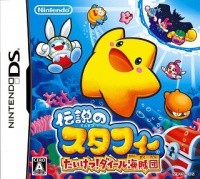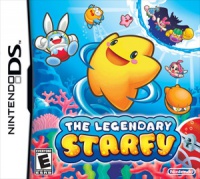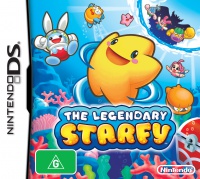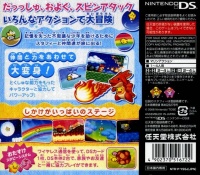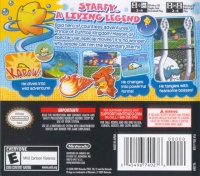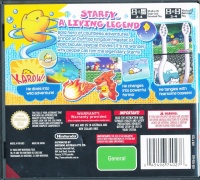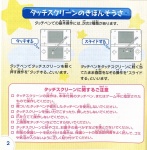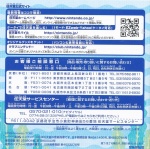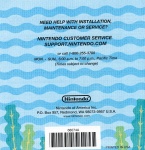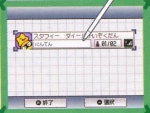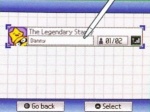The Legendary Starfy/Regional differences/distribution: Difference between revisions
From Starfy Wiki
Jump to navigationJump to search
Torchickens (talk | contribs) No edit summary |
Torchickens (talk | contribs) No edit summary |
||
| Line 100: | Line 100: | ||
*''Densetsu no Stafy Dairu Kaizokudan'' was originally rated in Japan by the [[wikipedia:Computer Entertainment Rating Organization|CERO]] 'A', as in 'All ages'. The North American and Australasian versions use different rating systems. The North American version is rated by the [[wikipedia:Entertainment Software Rating Board|ESRB]] 'E' for 'Everyone', and the Australasian version is rated by the [[wikipedia:ACB|Australian Classification Board]] 'G' for General audience. All ratings are visible on the bottom-left of the box. The ratings on the Japanese and Australian boxes are also visible on the spine. The rating on the North American box is visible on the bottom-left of the box only. | *''Densetsu no Stafy Dairu Kaizokudan'' was originally rated in Japan by the [[wikipedia:Computer Entertainment Rating Organization|CERO]] 'A', as in 'All ages'. The North American and Australasian versions use different rating systems. The North American version is rated by the [[wikipedia:Entertainment Software Rating Board|ESRB]] 'E' for 'Everyone', and the Australasian version is rated by the [[wikipedia:ACB|Australian Classification Board]] 'G' for General audience. All ratings are visible on the bottom-left of the box. The ratings on the Japanese and Australian boxes are also visible on the spine. The rating on the North American box is visible on the bottom-left of the box only. | ||
==Serial code== | |||
The product ID is NTR-YSSJ-JPN in the Japanese version, NTR-YSSE-USA in the North American version, and NTR-YSSE-AUS in the Australian version. | |||
[[Category:Regional differences]] | [[Category:Regional differences]] | ||
[[Category:Manual]] | [[Category:Manual]] | ||
Revision as of 16:55, 29 March 2021
This is a sub-article of The Legendary Starfy/Regional differences
This article covers regional differences relating to the distribution of Densetsu no Starfy Daīru Kaizokudan, known in North America and Australasia as The Legendary Starfy.
Box-Art
There are a number of differences between the Japanese, North American and Australasian box-arts.
-
Densetsu no Starfy Dairu Kaizokudan Japanese Boxart -
The Legendary Starfy
North American Boxart -
The Legendary Starfy
Australasian Boxart
Front
- Similarly to other Nintendo DS games, such as Pokémon Diamond the Japanese box of Densetsu no Starfy Daīru Kaizokudan is decorated with iridescent glitter. These include bubble and rhombus-like shapes. The iridescent effect is not present on the North American and Australasian boxes.
- Like other Japanese Nintendo DS games, the spine of the Japanese box of Densetsu no Starfy Daīru Kaizokudan features the name of the game written in plain white text on a black background, the Nintendo logo, and the CERO 'A' rating. English and Australasian versions have spines featuring the actual 'The Legendary Starfy' logo next to artwork of Starfy. These are placed on a background resembling the sea instead of the Japanese box's black background.
- The original artwork of Starfy has Starfy facing the front with a large grin. In the North American and Australasian box-arts, the grin is thinner and is shaped more like an elongated 'D'. In the North American and Australasian box-arts Starfy faces more to the side, performing a Spin Attack (English games: Star Spin).
- It appears that the positioning of some artwork on the boxes has shifted.
- On the Japanese box-art, more of the red treasure chest (bottom-right corner) is visible. On North American and Australasian versions about half of it is cut off the right side of the box-art.
- On the Japanese box-art, less of the coral and sea-weed is visible.
- The Japanese box-art features more bubbles behind Starfy compared to the North American and Australasian versions.
Minor Changes
- The Densetsu no Starfy logo was made wider in English and Australasian versions so that it would fit the text 'The Legendary Starfy' more suitably. The Japanese version features furigana and the text 'たいけつ!ダイール海賊団' (Daīru Pirate Squad) below the logo on a background made to look like a wooden board.
- In all three versions, bubbles surround the red treasure chest. On the North American and Australasian versions the bubbles were re-positioned so that they appear to come out of the keyhole.
- There are small differences near the scene featuring the Daīru Pirate Squad (English: The Terrible Trio) between the Japanese, North American and Australasian box-arts.
- More white dots are visible on Daīru's (English: Mashtooth) silhouette on the Japanese version.
- The cloud patterns are different.
- On the Japanese box-art, Densetsu no Starfy is marked with a registered trademark (®) symbol. On the North American and Australsian box-arts, The Legendary Starfy is marked with the regular trademark symbol (™).
- On the Japanese box-art, the Nintendo logo is printed on the top-left of the artwork. On the North American and Australsian box-arts, the Nintendo logo is printed on the bottom-right of the artwork instead. On Australsian boxes, the logo is the same size as it is on Japanese boxes. The logo is smaller on North American boxes.
- The bottom-right corner of the Japanese box-art features the product ID (NTR-YSSJ-JPN). English and Australasian games only have this written on the game card and the back of the box.
- The 'Nintendo DS' text is larger on North American and Australasian box-arts. The black section separating it from the box-art is also blurrier.
- On the Japanese and Australasian boxes, 'Nintendo DS' is marked with a registered trademark (®) symbol. On the Australasian box, The Legendary Starfy is marked with the regular trademark symbol (™).
Back
- Similarly to other Nintendo DS games, such as Pokémon Diamond the back of the Japanese box of Densetsu no Starfy Daīru Kaizokudan is decorated with iridescent glitter. These include bubble and rhombus-like shapes. The iridescent effect is not present on the North American and Australasian boxes.
- On the back of the Japanese box, the black section that includes information such as the barcode is aligned to the right. On the North American and Australasian boxes, the black section is near the bottom of the box.
- Starfy and Starly wearing the Beachwear (these are based on the actual models in the game) are shown on the black section of the Japanese box. This was not included on the North American and Australasian boxes.
- On the back of the Japanese box, there is a heading called 'しかけがいっぱいのステージ' ('Stages are full of tricks'). Underneath it are various screenshots not included on the North American and Australasian boxes. They include screenshots of Snowball Starfy, Starfy swimming across a rainbow in Skydye Heights (Japanese: にじの海, Rainbow Sea) and Starfy riding a minecart in Glitzem Grotto (Japanese: トロッコどうくつ, Truck Cave).
- Additionally there is a screenshot of Starfy gliding in Sogwood Forest (Japanese: シトシトの森, Gentle Forest) which was moved towards the center of the box on the North American and Australasian boxes.
- Below the aforementioned screenshots is a section covering Team Play mode. This section is not included on the North American and Australasian boxes. It includes artwork of Starfy and Starly and a screenshot of Starfy and Starly pushing a large boulder.
- The official Nintendo seal of quality and the ratings are not included on the back of the Japanese box. On the North American and Australasian boxes, they are included on the black section near the bottom of the box.
- On the back of the North American and Australasian boxes there are 'DS Single-Card Download Play' and 'Wireless DS Multi-Card Play' icons near the top-right corner of the box. On the Japanese box, they are down-sized and included in a smaller section on the black section.
- The back of the North American and Australasian boxes feature three screenshots not included on the Japanese version. These include the 'KAPOW!' scene where Starfy is about to beat up The Terrible Trio (Japanese: ダイール 海賊団, Daīru Pirate Squad) with a Star Spin (Japanese: Spin Attack) at the beginning of the game (annotated 'He dives into wild adventure!'), a screenshot of Starpedo (annotated 'He changes into powerful forms!' and a screenshot of Starfy avoiding Big Squiddy that takes up both screens (annotated 'He tangles with fearsome bosses!')
- On the back of the Japanese box there is circular icon that includes a screenshot of Starfy swimming across a rainbow. This icon was not included on the North American and Australasian boxes.
- Above the barcode on Japanese boxes, is the kanji '任天堂株式会社', meaning Nintendo Co. Ltd. This text was not translated and does not appear above the barcode on the back of North American and Australasian boxes.
- The Japanese barcode is 4902370 516722. The North American and Australasian versions share the same barcode of 045496 740276.
- On the bottom-left corner of the Australasian box there is a small section that is dark red. This does not appear anywhere on the Japanese or North American boxes.
-
The back of the Densetsu no Starfy Dairu Kaizokudan box -
The back of the North American The Legendary Starfy box -
The back of the Australasian The Legendary Starfy box
Manual
There are a number of differences between the Japanese, English and Australasian manuals.
- The Japanese and Australasian manuals feature the Product ID on the front of the manual. On the front of the Australasian manual, the Product ID (NTR-YSSJ-JPN) can be seen on the bottom-right corner and on the front of the Japanese manual, the Product ID (NTR-YSSE-AUS) can be seen on the top-right corner.
- The border that separates the Nintendo DS logo is less blurry on the Japanese manual.
- On the front of the Japanese manual, Nintendo DS is marked with a registered trademark (®) symbol. On the front of the North American and Australsian manuals, Nintendo DS is marked with the regular trademark symbol (™).
- Like other Japanese manuals of Nintendo DS games, the Densetsu no Starfy Daīru Kaizokudan manual has a page about tapping and sliding the touch screen. This page is not included in the North American and Australasian manuals.
- The back of the North American manual has text about contacting Nintendo Customer Service in addition to Nintendo of America's postal address. This does not appear on the back of the Australasian manual, which only features Nintendo Australia's postal address. The back of the Japanese manual has much more detail and features links to Nintendo's official website, Club Nintendo and a number of different telephone numbers.
- There is a dark red section on the bottom-left corner of the back of the Australasian manual.
- The Download Play screenshots (pages 30, 32) feature a user named 'Danny' in the North American and Australasian manuals with a blue border. In the Japanese versions (pages 29, 31) the user is named 'Ninten' (にんてん) and the border is gray.
-
The page in the Japanese manual about tapping and sliding the touch screen -
The back of the Japanese manual -
The back of the North American manual -
The Download Play screenshot in Japanese manuals -
The Download Play screenshot North American and Australasian manuals
Ratings
- Densetsu no Stafy Dairu Kaizokudan was originally rated in Japan by the CERO 'A', as in 'All ages'. The North American and Australasian versions use different rating systems. The North American version is rated by the ESRB 'E' for 'Everyone', and the Australasian version is rated by the Australian Classification Board 'G' for General audience. All ratings are visible on the bottom-left of the box. The ratings on the Japanese and Australian boxes are also visible on the spine. The rating on the North American box is visible on the bottom-left of the box only.
Serial code
The product ID is NTR-YSSJ-JPN in the Japanese version, NTR-YSSE-USA in the North American version, and NTR-YSSE-AUS in the Australian version.
